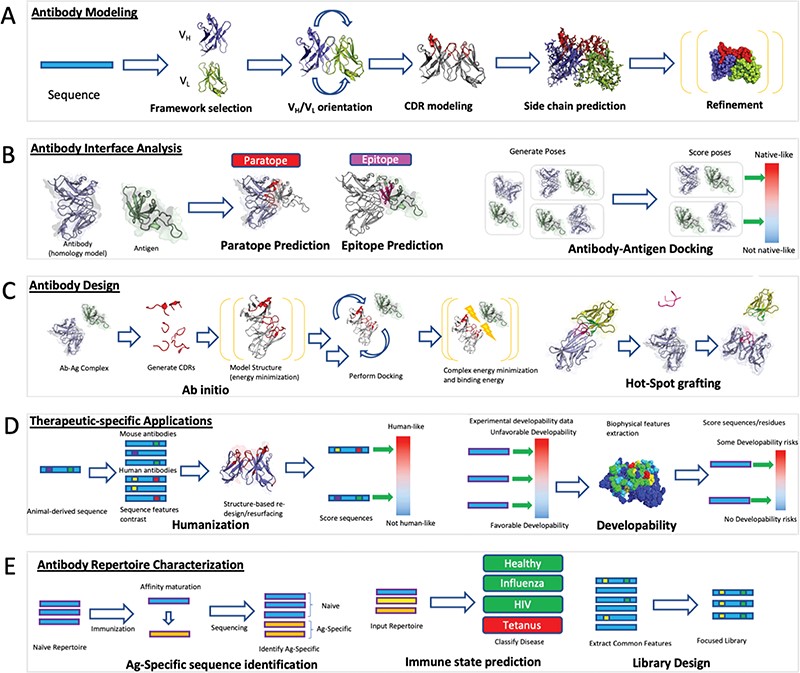The development of therapeutic antibodies has been significantly enhanced by advancements in computational methods and artificial intelligence (AI). These technologies have streamlined the antibody discovery process, improving the ability to identify and optimize antibodies with high specificity and efficacy.
The Role of AI in Antibody Design
AI and machine learning are now central players in the drug discovery pipeline. They facilitate the identification and optimization of novel antibody candidates with several key advantages:
- Generative AI: Models have been used to design antibodies from scratch for the first time, by predicting protein structures with high accuracy. This offers the potential to create entirely new antibody scaffolds with enhanced binding properties and therapeutic potential.1 An example of a generative AI model is AlphaFold 2, developed by DeepMind. This program achieved a near-atomic-level accuracy in predicting protein structures at the 2022 CASP (Critical Assessment of protein Structure Prediction) competition.
- Improved in-silico modeling: AI allows for robust in-silico modeling of antibody-antigen interactions. This facilitates the prediction of binding affinities and the virtual screening of vast antibody libraries, significantly reducing the need for laborious wet-lab experiments.
These advancements promise to enhance the binding properties and therapeutic potential of antibodies significantly.
Key Computational Approaches
- Structure-Based Design: Advances in structural biology, particularly with tools like AlphaFold, have revolutionized antibody design. These tools predict the three-dimensional structures of antibodies, allowing researchers to identify key binding sites on the target antigen, optimize antibody sequences to enhance their affinity and specificity for the target, and engineer antibodies to minimize off-target binding and potential side effects.
- Machine Learning Models: Biotech startups and pharma companies are now utilizing large datasets to predict the efficacy and safety of potential antibodies. These models analyze various data modalities, including genetic, proteomic, and clinical data, to identify promising therapeutic targets and optimize antibody sequences. This approach has significantly enhanced the efficiency of the antibody discovery process.2
High-Throughput Screening
Computational methods have improved high-throughput screening processes, allowing rapid assessment of large libraries of antibody candidates. Integration with automation and robotics can also vastly speed up the screening process, with consistent handling and processing of samples, reducing manual labor and increasing screening throughput. Computational pipelines can also be designed to analyze screening data in real-time. This allows researchers to adjust screening parameters or prioritize specific candidates based on the emerging data, further optimizing the screening process.
Applications
Recent studies highlight the practical applications of these computational approaches. For example, AI models have been used to assist in the design of drugs against COVID-19, demonstrating their potential in responding to emerging infectious diseases. For instance, the emergence of SARS-CoV-2 mutations resulted in new strains that impacted vaccine effectiveness, so Thadani et al. developed EVEscape, a deep learning generative model trained on historical sequences with biophysical and structural information. The model demonstrated accuracy similar to high-throughput experimental scans when anticipating pandemic variation for SARS-CoV-2. Ultimately, predicting probable further mutations to forecast emerging strains are a highly valuable tool for continuing vaccine development.3
Challenges and Future Directions
Despite significant advancements, several challenges remain in the computational design of antibodies. Ensuring the generalizability of AI models across different datasets and disease contexts is a major hurdle. Moreover, integrating diverse data types and maintaining data quality are critical for the success of these models. Future research should focus on improving the interpretability of AI predictions and developing robust validation frameworks to ensure the clinical relevance of computationally designed antibodies.
The computational design of antibodies represents a transformative approach in drug discovery, offering unprecedented speed and precision. By leveraging the power of AI and machine learning, researchers can develop more effective and safer therapeutic antibodies. Continued innovation and collaboration between computational scientists and biologists will be essential to fully realize the potential of these technologies in improving human health.
- Bennett, N., Watson, J., Ragotte, R., Borst, A., See, D., Weidle, C., Biswas, R., Shrock, E., Leung, P., Huang, B., Goreshnik, I., Ault, R., Carr, K., Singer, B., Criswell, C., Vafeados, D., Garcia Sanchez, M., Kim, H., Vázquez Torres, S., Chan, S., & Baker, D. Atomically accurate de novo design of single-domain antibodies. BioRxiv. (2024), https://www.biorxiv.org/content/early/2024/03/18/2024.03.14.585103
- Norman, R. A., Ambrosetti, F., J Bonvin, M. J., Colwell, L. J., Kelm, S., Kumar, S., & Krawczyk, K. (2020). Computational approaches to therapeutic antibody design: Established methods and emerging trends. Briefings in Bioinformatics, 21(5), 1549-1567. https://doi.org/10.1093/bib/bbz095
- Thadani, N. N., Gurev, S., Notin, P., Youssef, N., Rollins, N. J., Ritter, D., Sander, C., Gal, Y., & Marks, D. S. (2023). Learning from prepandemic data to forecast viral escape. Nature, 622(7984), 818-825. https://doi.org/10.1038/s41586-023-06617-0

